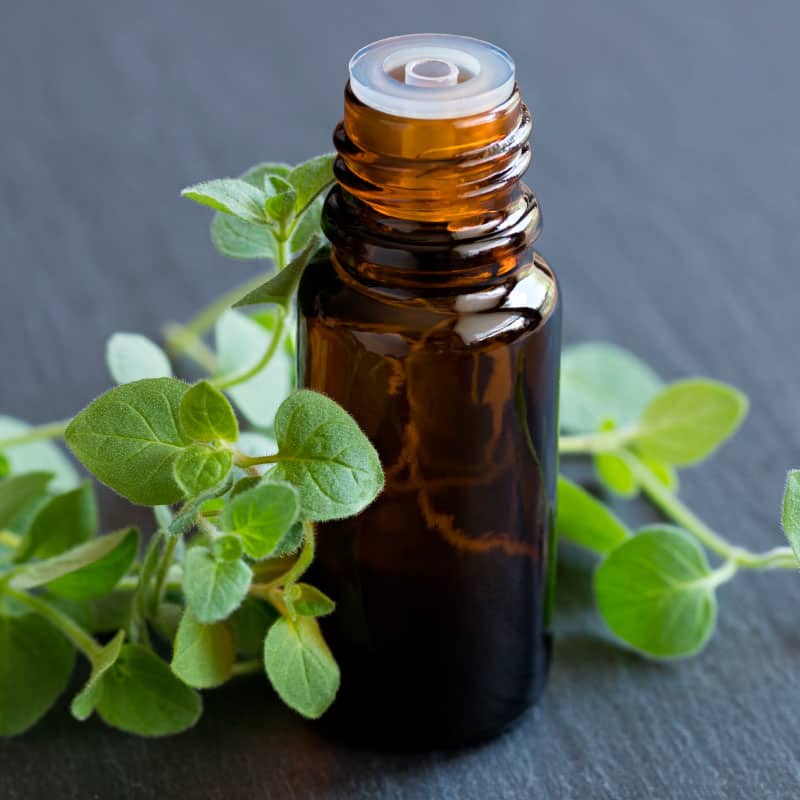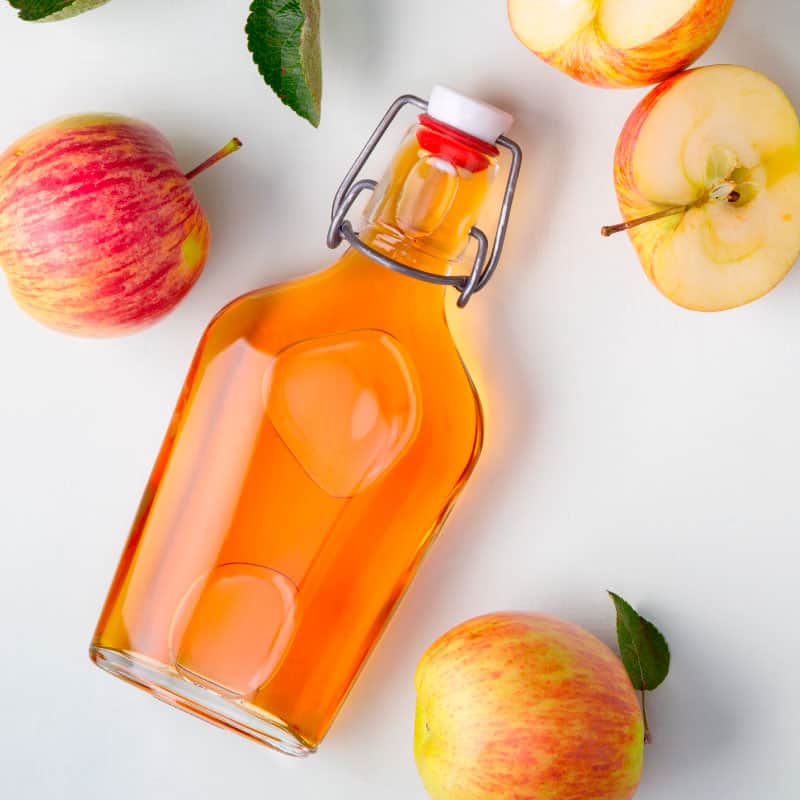This Dr. Axe content is medically reviewed or fact checked to ensure factually accurate information.
With strict editorial sourcing guidelines, we only link to academic research institutions, reputable media sites and, when research is available, medically peer-reviewed studies. Note that the numbers in parentheses (1, 2, etc.) are clickable links to these studies.
The information in our articles is NOT intended to replace a one-on-one relationship with a qualified health care professional and is not intended as medical advice.
This article is based on scientific evidence, written by experts and fact checked by our trained editorial staff. Note that the numbers in parentheses (1, 2, etc.) are clickable links to medically peer-reviewed studies.
Our team includes licensed nutritionists and dietitians, certified health education specialists, as well as certified strength and conditioning specialists, personal trainers and corrective exercise specialists. Our team aims to be not only thorough with its research, but also objective and unbiased.
The information in our articles is NOT intended to replace a one-on-one relationship with a qualified health care professional and is not intended as medical advice.
How to Get Rid of a Keloid
September 26, 2023
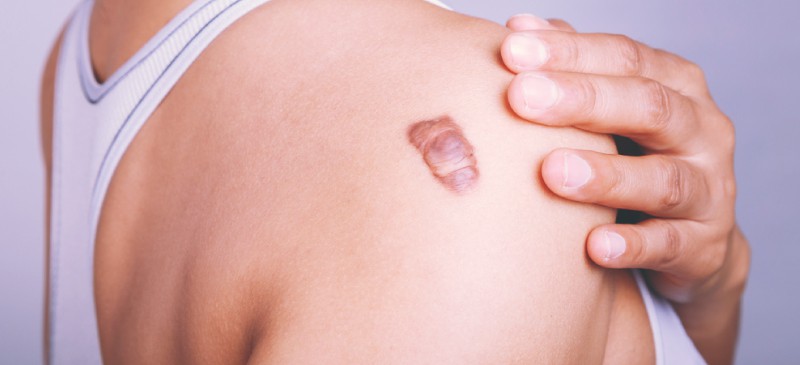
Keloids — scars that just keep on growing — are typically harmless. However, they can be unsightly and annoying. They affect as many as 1 in every 10 people and most often appear after injury to the skin.
Trying to remove keloids surgically is often ineffective. However, both medical and natural treatment methods can help reduce their appearance. In some cases, future keloids can also be prevented.
What Is a Keloid?
A keloid is a scar that has grown beyond what is needed to heal broken skin. It is often large, shiny and raised in a bump or line off the skin. Keloids form as skin injuries heal, but they often end up significantly larger than the original cut or wound.
Keloids are usually darker than your normal skin tone and can also be itchy. They tend to affect people with darker skin tones and occur most frequently in people under the age of 30. Areas of the skin that are particularly at risk are the ears, cheeks, chest, shoulders and upper arms.
As many as 5 percent to 15 percent of all wounds heal with a keloid. These large bumps should not be confused with hypertrophic scars, which stay within the boundaries of the original wound and may go away on their own.
Instead, keloids are technically non-cancerous (benign) skin tumors. They can form any time within a year of the original injury. Keloids do not turn into cancer. Instead, they are made of skin that simply has lots of extra connecting fibers, called collagen.
Can tattoos turn into keloids?
These irksome scars are most likely to form when skin has a hard time healing, as with burns or piercings. However, any damage to the skin can increase your risk of keloids, since the lumpy scars form during the healing process. The National Health Service in the United Kingdom recommends against tattoos if you have keloid concerns.
Can you get rid of a keloid?
There are some conventional therapies that may help treat keloids. In some cases, you can permanently remove a keloid. Many people do respond to initial treatments, at least in the short term.
However, both conventional and natural approaches have limited success entirely removing and keeping keloids from returning. There is evidence that keloids can be prevented, if you know to expect them.
Do keloid scars ever go away on their own?
Keloids do not disappear on their own. However, they may get smaller or less different in color to your normal skin tone with time.
Signs and Symptoms
Keloids vary in appearance from person to person. They grow slowly over several months to a year and, after some time, may start to shrink a little. In general, however, keloid symptoms include:
- Large, bumpy, raised scar tissue that grows beyond the size of the original wound
- Shiny, hair-free skin on the scar
- Red, purple, pink or brown scar tissue that is often darker than your normal skin color (hyperpigmentation)
- Soft and doughy to rubbery and firm to the touch
- Itchy or burning sensation in the scar (pruritus)
- Slow growth of the scar over a period of several months to one year
Causes and Risk Factors
Researchers don’t really know of any true keloid causes other than injury to the skin. There are some genes linked to keloids, but no single genetic cause. Keloids likely develop from a combination of genetic and environmental factors.
Common causes of keloids include:
- Body piercing (especially ear piercing)
- Tattoo
- Acne or chicken pox (usually developing on the face, chest, or back)
- Burn, cut scrape or bug bite
- Deep wound, such as a puncture wound
- Wound caused by surgery, a procedure or an injection
- Skin disease that causes inflammation like folliculitis
Risk factors for keloids include:
- Dark skin
- Asian or Latino ethnicity
- Prior formation of a keloid
- Age 10 to 30 years
- Family members with keloids
- Being pregnant
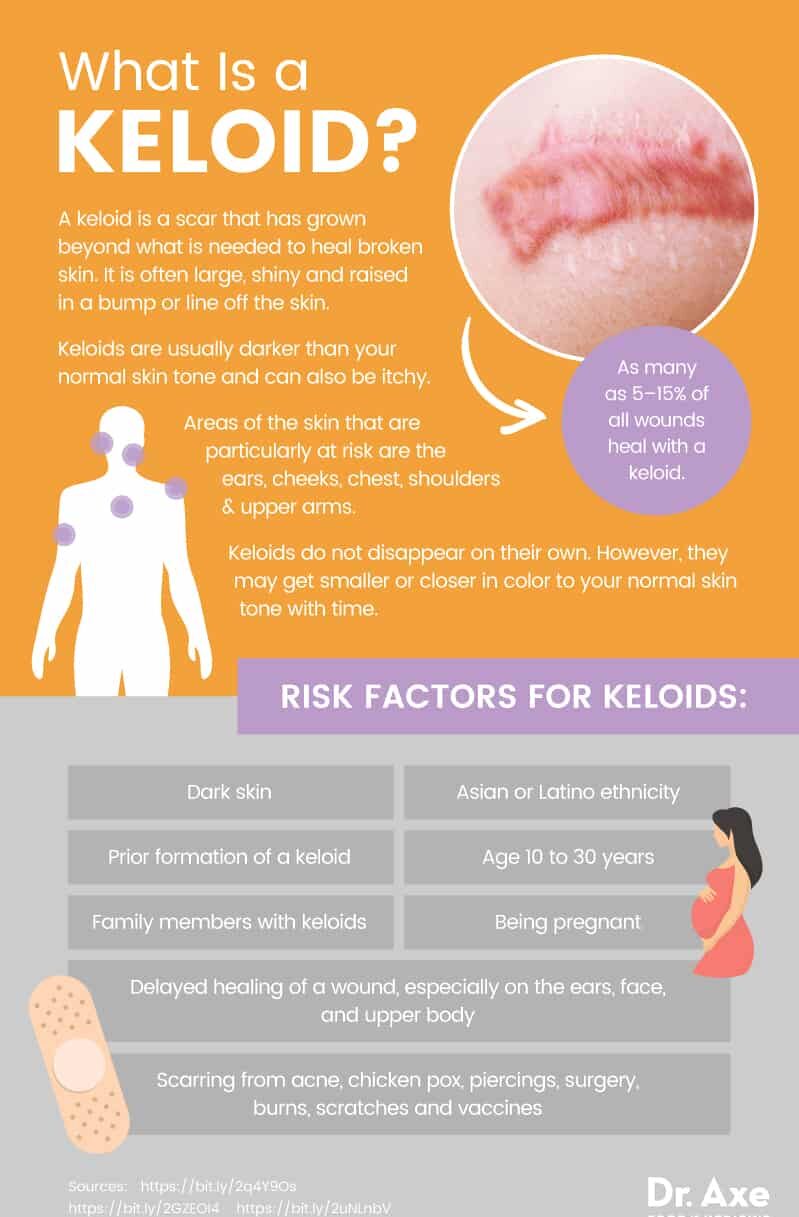
Conventional Treatment
Keloid treatment may depend on how bothered you are by the scar, how large it is and what treatments you have already tried. Options may include:
- Corticosteroid injections — The medicine is injected into the scar. This approach is often the first line of treatment and many people do notice improvement in the scar’s size.
- Surgical keloid removal — This is usually coupled with corticosteroid injections or other methods to keep the keloid from returning, including radiation.
- Silicone dressings — Silicone is used to make gel sheets or dressings that cover the entire area of skin with the keloid. The sheets can reduce their size considerably.
- Compression — Custom-made molds may be made to fit over the keloid to create pressure. Over time, they may shrink the keloid.
- Cryotherapy — Freezing the keloid with liquid nitrogen may also reduce the size of the scar effectively.
- Interferon or 5-fluoruracil therapy — These medications are injected directly into the scar to shrink it. This type of therapy is also known as intralesional therapy.
- Imiquimod therapy — This is a keloid cream applied to the skin to shrink the scar or prevent a keloid from forming after surgery.
- Other options — These include drugs such as Flurandrenolide tape (Cordran), Bleomycin, Tacrolimus, Methotrexate, Pentoxifylline (Trental), Colchicine, topical zinc, interlesional verapamil, cyclosporine, D-penicillamine, relaxin and topical mitomycin C.
Even the most successful conventional therapies don’t always remove a keloid permanently. All options have high rates of keloid return after therapy.
You should follow up with your healthcare professional according to your treatment schedule. If you notice that the keloid seems to be coming back, return for treatment as soon as possible. Early treatment of a forming keloid is more likely to be successful than waiting until it is fully grown.
Natural Remedies
How to get rid of keloids has some overlap with natural ways to get rid of scars. However, keloids are made up of skin cells that are a bit different — and much stronger — than normal scars. You can try some of the home remedies below to lighten the appearance or even shrink the size of your keloids.
Before you begin, though, talk to your healthcare professional. Some people may have bad reactions to treatments applied directly to their skin. Get care from a healthcare professional if you notice extreme skin irritation, worsening of the keloid or signs of allergy or infection.
1. Honey
Both raw honey and Manuka honey have long been used in dressing wounds. It has well-documented antimicrobial properties that can help fight infections in skin injuries.
Although keloid-specific research is limited, one research study found that honey as well as honey combined with Calotropic Procera (also called milkweed, apple of Sodom, or roostertree) was effective in limiting and healing keloid-like scars in animals.
In addition, a review of studies on the antimicrobial and anti-inflammatory properties of honey called out its potential for keloid therapy. The researchers believe that honey’s impact on keloids is likely due to its anti-inflammatory properties, which may calm the skin. Honey may be most useful when applied during the initial healing process, however.
A clinical study in children also found that extracts of tualang honey were also effective in stopping the growth of a keloid scar.
To use hone for a keloid, simply dab honey onto the keloid at least two or three times a day. Use a raw, minimally processed honey, or the darkest honey you can find to maximize your exposure to its health benefits.
You can apply it more often if needed. Wash the honey off when the area gets too sticky or dirty.
2. Onion
Several clinical studies have found onions to be a useful treatment for keloids. This is probably because it contains quercetin, which has anti-inflammatory and antioxidant effects. Researchers have studied the use of onion extract gel applied to the skin, including under dressings and compresses.
Although onion extract gel has been used effectively for keloid prevention and treatment on its own, other studies combined it with traditional medications and found it boosted reduction of keloids.
The study where the gel alone was effective included Asian women with scarring from cesarean section births. They applied a 12 percent topical onion extract gel three times a day for 12 weeks and had smaller, less noticeable scars than those who applied a placebo gel.
You can try a similar approach at home by cutting an onion into small pieces, then pressing down on them with a clean towel to squeeze out the juice.
Dab the juice on the keloid, or place just the wet towel on the keloid. Let it dry. Rinse your skin. Repeat up to four times per day.
3. Crushed garlic
Garlic has many potential benefits for the skin. Laboratory findings showed it may act in much the same way as some current conventional treatments for keloids, making it a promising possible remedy.
To use, crush a few garlic cloves (ideally with a garlic press) and apply them directly to the skin. Rinse after 15 minutes or if you start to notice irritation.
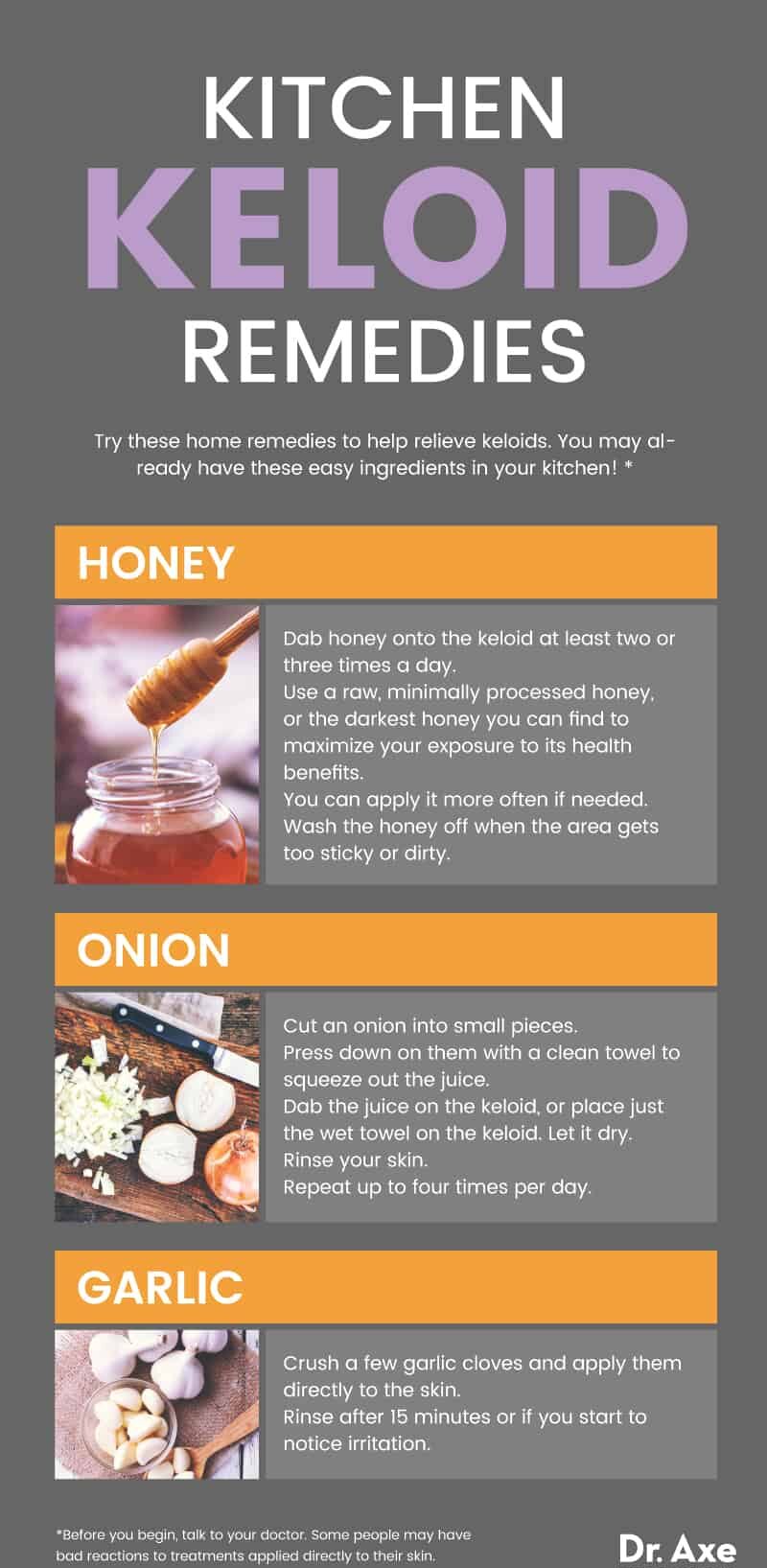
4. Homemade retinol cream
Retinoids are derived from vitamin A. Laboratory studies have found that they can break down the fibers in keloids.
You can make a homemade version of common store-bought retinol (a type of retinoid) creams by following this recipe for retinol cream.
5. Other scar minimizers
There is some evidence that other plant-based substances can also fight scarring. These include:
- Resveratrol
- Green tea (technically, the epigallocatechin gallate (EGCG) in green tea)
- Oleanolic acid
- Curcumin
- Shikonin (derived from Lithospermum erythrorhizon, a Chinese herb)
- Emodin (derived from Himalayan rhubarb, buckthorn and Japanese knotweed)
You can also try other approaches to manage your keloids:
- Camouflage. If you would like to cover keloids for appearance’s sake, you can use makeup to help the color of the keloid match your skin tone. This may make the keloid less noticeable.
- Acupuncture. Some studies report an improvement in itchiness, color, and size of a keloid after careful acupuncture.
How to Prevent
Learning how to get rid of keloids may not be as useful as learning how to prevent them in the first place. If you are prone to getting keloids, or if someone in your family has them, you should take steps to prevent the formation of keloids.
Ways to prevent keloids include:
- Avoiding injury to the skin, including by piercings, tattoos and surgery.
- If you get an ear piercing and notice the skin on an earlobe start to thicken, immediately remove the earring and start wearing a pressure earring instead.
- Taking extreme care to avoid infection after any skin injury, including surgery.
- Adding medications, radiation or ointments after surgery, with your surgeon’s or dermatologist’s guidance.
- Covering new wounds or forming keloids with pressure garments or sheets or adhesive bandages.
- Wearing sunscreen.
- Post-surgery massages 10 minutes twice a day to 30 minutes twice a week near the incision site may promote healthier healing and prevent keloids, but research is mixed.
Precautions
- Not all promising scar-fighting agents have much formal research on them. Any natural remedy should be used with caution and under the advisement of your health care provider.
- You should stop using any homemade or natural therapy if you experience irritation.
- Seek medical care if you experience significant pain, burning, irritation, itching, signs of infection or any other symptom that worries you.
- Speak with your dermatologist about the most effective options and how to keep keloids from returning after treatment.
Final Thoughts
- Keloids are exaggerated scars that grow beyond the original injury on the skin. They are often red, pink or brown in color.
- The scars are raised, lumpy scars that are often shiny in appearance. They can be very itchy.
- Keloids are common, forming during the healing process of 5 percent to 15 percent of all skin wounds. They are much more likely to form in people with darker skin tones and in people ages 10 to 30.
- With treatment, keloids can often be effectively shrunk, removed or prevented.
- Natural approaches to keloid management include honey, onion, crushed garlic, homemade retinol cream and other scar minimizers.




